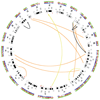SNP and haplotype mapping for genetic analysis in the rat
- PMID: 18443594
- PMCID: PMC5915293
- DOI: 10.1038/ng.124
SNP and haplotype mapping for genetic analysis in the rat
Abstract
The laboratory rat is one of the most extensively studied model organisms. Inbred laboratory rat strains originated from limited Rattus norvegicus founder populations, and the inherited genetic variation provides an excellent resource for the correlation of genotype to phenotype. Here, we report a survey of genetic variation based on almost 3 million newly identified SNPs. We obtained accurate and complete genotypes for a subset of 20,238 SNPs across 167 distinct inbred rat strains, two rat recombinant inbred panels and an F2 intercross. Using 81% of these SNPs, we constructed high-density genetic maps, creating a large dataset of fully characterized SNPs for disease gene mapping. Our data characterize the population structure and illustrate the degree of linkage disequilibrium. We provide a detailed SNP map and demonstrate its utility for mapping of quantitative trait loci. This community resource is openly available and augments the genetic tools for this workhorse of physiological studies.
Figures


References
-
- Jacob HJ, Kwitek AE. Rat genetics: attaching physiology and pharmacology to the genome. Nat Rev Genet. 2002;3:33–42. - PubMed
-
- Bihoreau MT, et al. A linkage map of the rat genome derived from three F2 crosses. Genome Res. 1997;7:434–440. - PubMed
-
- Zimdahl H, et al. A SNP map of the rat genome generated from cDNA sequences. Science. 2004;303:807. - PubMed
-
- Thomas MA, Chen CF, Jensen-Seaman MI, Tonellato PJ, Twigger SN. Phylogenetics of rat inbred strains. Mamm Genome. 2003;14:61–64. - PubMed
Publication types
MeSH terms
Grants and funding
LinkOut - more resources
Full Text Sources
Other Literature Sources
Molecular Biology Databases
Research Materials
Miscellaneous

